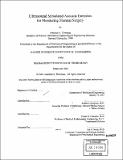Ultrasound stimulated acoustic emission for monitoring thermal surgery
Author(s)
Thierman, Jonathan S. (Jonathan Sidney), 1976-
DownloadFull printable version (8.034Mb)
Other Contributors
Massachusetts Institute of Technology. Dept. of Mechanical Engineering.
Advisor
Kullervo Hynynen and Ernest G. Cravalho.
Terms of use
Metadata
Show full item recordAbstract
Therapeutic ultrasound describes a non-invasive surgical technique by which high-energy ultrasound is delivered to malignant tissue. This method must be monitored in order to ensure that the correct tissues are treated and that the tissues are treated with the proper dose. Typically, therapeutic ultrasound has relied on MRI techniques to monitor the extent of the thermal surgery. Besides for the great cost and limited availability, MRI monitoring presents limitations for therapeutic equipment design because all other equipment must be compatible with the large magnetic fields created by the MRI system. A new method of monitoring is explored which uses a method coined Ultrasound Stimulated Acoustic Emission, USAE. This relatively new material property measurement method presented by M. Fatemi and J.F. Greenleaf in Science May 1998 relies on the low frequency stimulation of a material by overlapping two slightly differing high frequency ultrasound beams in a pattern which creates a region of low frequency, known as a beat frequency. The resulting low frequency stimulus is highly focused and localized. The low frequency pressure field causes cyclic forces and induces a mechanical displacement in the object being imaged. The low frequency response of the object from the ultrasound stimulus reveals information about the mechanical and ultrasound properties of the object, namely its stiffness and acoustical absorption coefficient. A diagnostic ultrasound system applying the USAE method for imaging biological tissues was designed and constructed for use in this thesis. In a series of experiments presented in this thesis, the USAE method is applied to imaging ex vivo porcine and rabbit tissue. Lesions are created with focused ultrasound and raster scanned in the focal plane by the two intersecting focused ultrasound fields to image the necrosed tissue. This method successfully rendered high-resolution images of the necrosed lesions. In addition, the amplitude of the USAE responses correlate well with temperature measurements in a study of nine samples of porcine fat and nine samples of porcine muscle. Evidence including a broadband response and fluctuating USAE amplitude indicate that the USAE method may also be used to detect cavitation events in tissue. The images and the temperature measurements demonstrate the effectiveness of the USAE method for imaging and monitoring biological tissue in conjunction with thermal therapy.
Description
Thesis (S.M.)--Massachusetts Institute of Technology, Dept. of Mechanical Engineering, 2001. Includes bibliographical references (leaves 88-93).
Date issued
2001Department
Massachusetts Institute of Technology. Department of Mechanical EngineeringPublisher
Massachusetts Institute of Technology
Keywords
Mechanical Engineering.